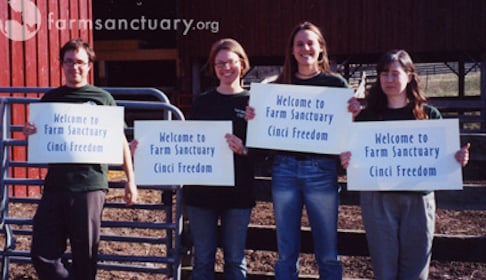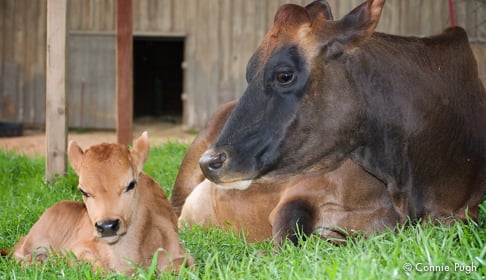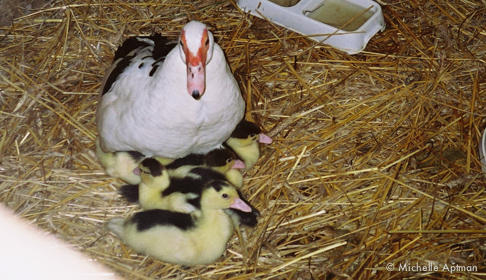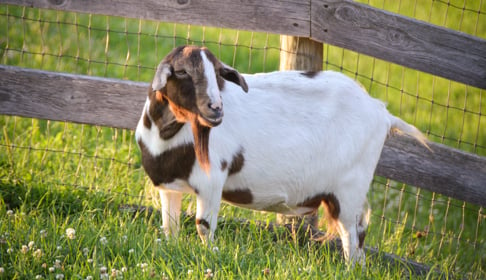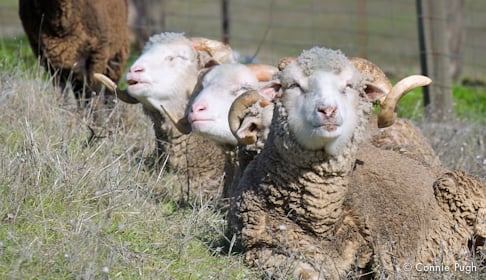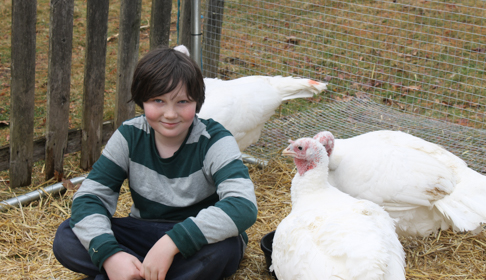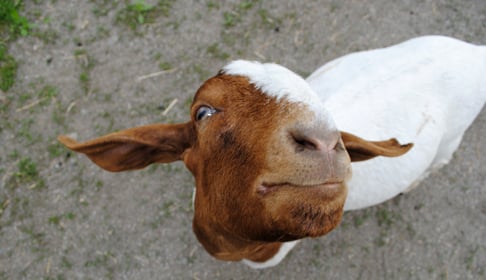By Susie Coston, National Shelter Director
Winters at the New York Shelter always present challenges. This one was especially brutal, with record-low temperatures in February and scathing wind-chills throughout the season, but it was no match for our dedicated shelter team.
Since few visitors ever see the shelter between the end of October and the beginning of May, I thought I’d share a glimpse of what living the (freezing) Farm Sanctuary life is like during the reign of winter.
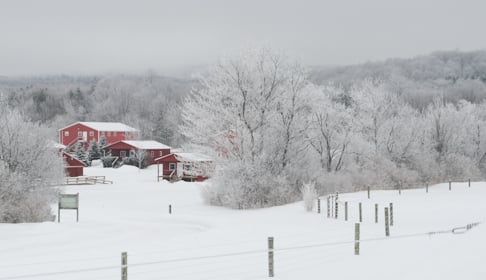
Suiting Up
Every day this winter, staff members were out and about from dawn until after nightfall, in wind chills as low as negative 35 degrees. Naturally, this requires a lot of clothing: layer upon layer, topped off with heavy-duty boots, hats, gloves, and facemasks. Moving around in all that is no easy task. It’s like working in a space suit!
The shelter’s humans aren’t the only ones who suit up. Our elderly sheep and goats, as well as the very young ones and anyone who has little body fat or just gets chilly, is outfitted with a special coat to keep them cozy. This year several of our turkeys molted in the middle of winter, so caregiver Abbie Rogers sewed them their own warm (and fabulous) jackets.

Ice, Ice, Baby
While most shelter residents prefer to stay inside during the worst of winter, the cattle love to go out in all conditions. They even run and play in the snow. Since a fall could be devastating for these massive creatures, it’s crucial to keep their walkways ice-free. Salt is harmful to the animals’ feet, so staff fight the ice with sand, shoveling tons of it by hand over the course of the season.
On top of the battle with ice is the battle with snow. It was a seriously snowy winter this year, and the roads, paths, and animal areas were often buried under tremendous drifts that made the shelter grounds look like a frozen seascape. Plowing our vital walkways was a constant task for the barn cleaners. This tenacious team kept our paths clear all season, even when it got so cold that the tractors wouldn’t start.
The Barn Dance
Barn conditions are a tricky, high-stakes business in the brutal cold of winter. The barns must provide enough weather protection to keep the animals warm but, especially in the case of the large animals, must also admit enough airflow to prevent the atmosphere within from becoming moist, which would put the animals at risk of pneumonia. Regulating this takes attention to detail. Doors are kept open or closed strategically, every barn has a thermometer, and we keep a close eye on the weather.
It’s also important, as always, to keep the barns clean. In the summer, barn cleaners move the animals out of the barns for more efficient cleaning (and most of the animals are already outside anyway), but once it gets cold, it is no longer safe to do so. Instead, the cleaners must work around the animals, shifting them around the barn as they go. This slows down the operation, but it’s worth it to keep everyone safe and cozy.
Creature Comforts
The cleaners have a lot of straw to contend with in the pig barn, where we pile it knee-high during the cold months. The pigs build big nests for themselves, burrow down, and largely disappear from view until spring.
In their barns and sheds, our chickens and turkeys keep warm with ceramic heat-lamps (sent back to the manufacturer every year for safety checks). Along with the ducks and geese, they spend most of the coldest months inside; they prefer to stay nice and warm, and their beaks, bills, and feet can be vulnerable to frostbite. With plenty of space to roost, stroll, socialize, or have a private moment, the birds can get on with their lives even as the wind howls outside.
Like the birds, the goats hate the cold, and most stay in their barn. About 15 of them wear coats for additional warmth. The sheep, on the other hand, have their wool to keep them warm and tend to take the winter in stride. We do keep our special-needs sheep separate from the main flock so we can make sure they don’t fall or get stuck outside in the cold.
Our new mothers and babies, along with some of our elderly animals who have trouble staying warm, spent the season in our three warmest buildings. Our Melrose Small Animal Hospital, Rescue and Rehabilitation Barn, and Healthcare Hospital all have radiant-heat flooring, and our most vulnerable animals were safe and comfortable there all winter.

Water, Water Everywhere
One of the many tasks complicated by winter weather is supplying the animals with water. It got so cold this year that the pipes beneath multiple barns and sheds froze, disabling many auto-waters and obliging staff to haul water to the animals. Any caregiver in charge of feeds and waters inevitably got wet — you could hear them coming from the ice rattling on their pants.
So. Much. Hay.
We have 50 cattle, 75 sheep, and 40 goats at the shelter. When pasture is available, these ruminants eat mostly grass. During the other six (or, in the case of this year, seven) months of the year, they eat hay. Food is the fuel they need to keep their bodies warm, and the colder it gets, the more fuel they need. During the depths of this winter, we were going through about six and half tons of hay every week.
Distributing all that hay takes not only elbow grease but also know-how. Different groups of animals get different types of hay. For instance, elderly animals who are missing teeth and/or have trouble keeping weight on their bodies are given a soft, rich grass hay. Heartier animals are given a hay that is not so rich, to keep them from becoming overweight. Male goats and donkeys require specific nutrients in their hay to prevent certain health issues.
In addition to hay, our elderly goats and two of our elderly cows receive a special mash that’s easier for them to eat. This is typically prepared by our interns. Yes, there are folks who choose to intern with us during the coldest, snowiest, iciest time of year, and we are grateful for them.
Extra Care
During the winter, you won’t find one staff member here who doesn’t know the forecast. We pay constant, close attention to the weather, the conditions in the barns and yards, and especially the animals. We watch for any signs of discomfort or illness, which is a particular risk during the temperature fluctuations toward the end of the season. By that point, many of the animals have a serious case of cabin fever. Things can get pretty rowdy in the barns, as their residents act out like kids stuck inside too long. We certainly can’t blame them for getting antsy.
The increased difficulty and discomfort of the work, as well as concern over keeping the animals safe and healthy through it all, can be exhausting, so we also pay close attention to each other. We check in often, make sure people are taking breaks and giving themselves a chance to thaw out. When the cold descends, we all draw a little closer together, both animals and people, everyone feeling a little extra grateful for the warmth and support of the shelter family.

Extra Joy
And then, after all that, suddenly it’s spring.
Coats are shed (or sheared), the ducks and geese return ecstatically to their pond, the pastures turn a dazzling shade of green, and everyone comes out to soak up the sunshine. The animals bask in it for hours. They run, they play, stretch their legs, and kick up their heels. We all get a little giddy. We’ve made it through another winter, together.






